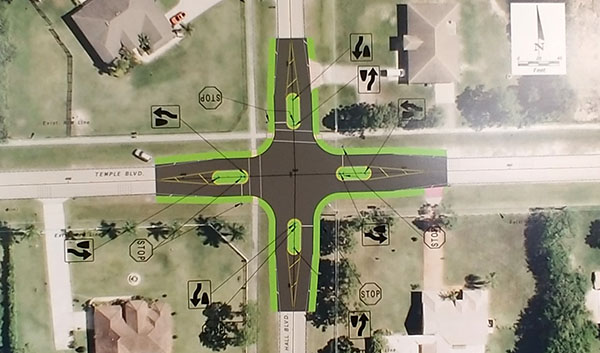
The Florida Department of Transportation held a public information meeting Thursday, Sept. 26 on a $610,000 traffic calming project within the Indian Trail Improvement District approved by the Palm Beach Transportation Planning Agency.
The meeting at the ITID office drew about 50 residents and public officials.
The project will place raised islands on portions of Temple and Hall boulevards and 140th Avenue North, as well as a raised intersection with median dividers at the intersection of Temple and Hall.
The project is part of ITID’s overall traffic calming plan.
“It’s fully funded by FDOT,” ITID President Betty Argue told the Town-Crier on Tuesday. “It’s a portion of our overall traffic calming plan.”
Argue explained that the TPA approved plans developed by ITID traffic engineer Joe Capra of Captec Engineering, submitted in a grant application written by Ryan Ruskay of RMPK Funding. The money was approved in 2017, but the funding was three to five years out.
“They plan to begin the work in the fall or winter of 2020 with completion in the spring of 2021,” Argue said. “We have a problem in the district with some high-crash locations, and we’ve identified those. Through Captec, we’ve done studies, and we have to do whatever we can do to slow people down and eliminate those high-speed crashes. There’s the safety issue for all our residents, because of people cutting through and speeding on our residential roads. We really don’t have any choice at this point but to try and calm the traffic.”
She is pleased to have FDOT support for the project.
“This is a more uniform way of dealing with it,” Argue said. “Obviously, the FDOT project is not something the district can afford to do on our limited budget, so the grant funds helped us to do something more permanent. The other part of the plan is a pilot project, which still has not been completed, but once we determine whether or not that’s effective, it’s a more affordable option that we can work into our budget to be able to address throughout the district problem areas.”
She said that ITID will continue to apply for grants to underwrite parts of the remaining traffic calming plan.
“We’re going to continue to build on applying for grants from the TPA to assist us in doing what we need to do, but the other important part is that in order to qualify for this particular grant program, it has to be on roads that are functionally classified for the FDOT and TPA funds,” Argue said. “We have very limited roads that are functionally classified roads that would qualify for the grant money. That’s why these three roads were chosen.”
While the FDOT project is underway, the district will coordinate culvert replacement under some of the speed tables so that they are replaced simultaneously.
“When FDOT is ready to begin their project, we’ll go in beforehand and get those culvert projects done so they’ll be ready for FDOT to come in and do their project,” Argue said.
At the hearing, FDOT Design Project Manager Anson Sonnett said the intersection at Hall and Northlake boulevards, where a high number of crashes have been reported, will be addressed in a separate FDOT project to begin in a year or so. “We have different programs that the federal government sets up to spend money on local roads, and those are administered through the department,” Sonnett said. “What the local agency will do, in this case, the Indian Trail Improvement District, they will go to the Palm Beach TPA, and the TPA will agree to this and say, ‘This is a priority.’ We look at it from an engineering perspective, but we never go back and say, ‘There was never enough accidents to put in a speed table.’ We’ll engineer it and build it.”
FDOT Engineer Damaris Williams said the project under discussion is to address internal speeding within ITID.
“From my understanding, Northlake Blvd. is a state road, so that is something [FDOT] would have control over in studies and meeting the needs and safety limits of a state road,” Williams said. “But Hall, Temple and 140th is within the district, so this is what the project is focusing on.”
Williams said the purpose of the project on Hall, Temple and 140th is to address speeding on those roads.
“The mid-blocks presented on Temple Blvd., which is at two locations, and then 140th at three locations, are speed tables… to anticipate cars to slow down,” she said. “At Hall Blvd., there are three locations where speed tables are proposed, and at the intersection [at Hall and Temple], there will be median islands at all four approach legs to slow down the traffic approaching the intersection. It seems that this is a major focal point.”







